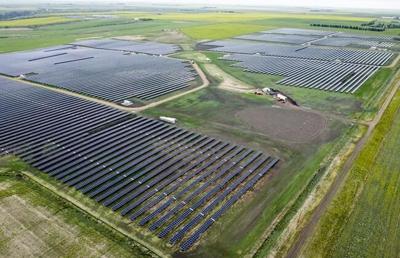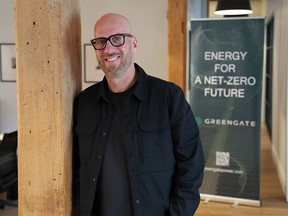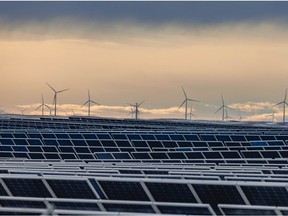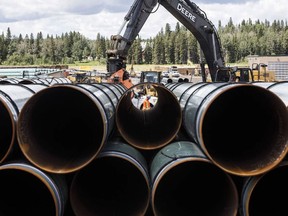CANADA
Pension funds improving modestly on climate but still too slow: report
, The Canadian Press
Canada's largest public pension funds are showing modest improvements on climate action but are moving too slowly overall, says a new report by a climate advocacy group.
The progress report from Shift Action for Pension Wealth and Planet Health notes that four of the 11 pension plans it examined still don't have emissions reduction targets for 2030 or 2050.
It also says many of the pension funds are still not being transparent about their fossil fuel holdings, and none have acknowledged the need to phase them out.
Adam Scott, executive director of Shift, said it's important pension plans take action both to reduce investment risk and climate risk.
"It's not just about defending their own portfolios, it's also about addressing the wider crisis systemically."
The report notes there were some improvements, including the first climate plans out of the Ontario Municipal Employees Retirement System and the Healthcare of Ontario Pension Plan.
But Scott said there has also been misalignment with some pension plans and their actual action, including at the Canada Pension Plan Investment Board.
The CPPIB, one of the few to still not set out interim emissions reduction targets, was the only one to slip in its letter grade in the report.
"We're quite disappointed to see a pattern of public communication from CPPIB that is offside with their own net-zero plans and commitments," he said.
There were multiple examples of pension plans continuing to invest in fossil fuel companies that have plans for expansion, which creates a risk, given the transition and the long-term investment horizons of pensions, said Scott.
"When they decide to sell, is there somebody else willing to pay for it? That's where the risk really comes in."
The Alberta Investment Management Corp. received the worst grade among the 11 Canadian pension plans analyzed for the second year, as Shift says it sets no clear targets and has yet to put out a credible climate plan.
This report by The Canadian Press was first published Feb. 27, 2024.
Canada's top pensions have trillions in assets.
Should they do more to fuel the energy transition?
New report analyzed pension funds for climate targets — and many fell short
Canada's largest pension funds, which hold trillions of dollars in assets combined, are trailing behind many of their international counterparts when it comes to shifting away from investments in fossil fuels, a new report has found.
The report, released Tuesday by the advocacy group Shift Action for Pension Wealth and Planet Health, evaluated the policies of 11 of the country's largest pension managers against international best practices, as well as global targets to reduce greenhouse gas emissions.
The report found some progress since the group's first assessment, released last year, but on the whole found that most of Canada's pension managers still lag when it comes to climate commitments.
"What we're seeing is progress, which is great to see, but the pace of that progress just isn't fast enough to protect pensions and to align more broadly with climate goals," Adam Scott, executive director of the advocacy group, said in an interview.
Climate activists in Canada and beyond have been increasing pressure on pension managers to steer away from fossil fuel investments toward renewable energy.
Some pension funds in other jurisdictions have already begun divesting from fossil fuels.
Big changes abroad
The report cites New York City pension funds, as well as others in France and Netherlands, as examples of how to be more transparent about investments, help fund the renewable energy sector and use shareholder resolutions to demand climate action from companies.
Earlier this month, another Dutch fund, PFZW, divested its holdings in Europe's biggest oil and gas companies, saying they are not reducing emissions fast enough.
In Canada, by contrast, four of the 11 pension funds listed still do not have emissions reductions targets for both 2030 and 2050, according to the report.
Part of the problem may be "entanglements" at the board level between the pension sector and oil and gas production in Canada, the report's authors argued.
Seven of the 11 pension funds have at least one director or trustee who is also the director or executive of a fossil fuel company, the report said.
Quebec pension fund scores high
For the second year in a row, the Caisse de dépôt et placement du Québec (CDPQ) scored highest in climate leadership among the funds analyzed, with the University Pension Plan (UPP) in Ontario placing second.
The CDPQ, which has net assets totalling $434 billion, completely divested from oil production, refining and coal mining in 2022 and increased its investments in low-carbon assets to $47 billion, according to the report.
UPP, a smaller fund representing university workers with about $11 billion in net assets, was praised for its transparency with beneficiaries and for working toward having a net-zero portfolio by 2040.
The biggest improvements came from the Ontario Municipal Employees Retirement System (OMERS) and the Healthcare of Ontario Pension Plan (HOOPP), funds that were previously far behind but released climate strategies in 2023.
The Alberta Investment Management Corporation (AIMCo), which holds $158 billion in assets, ranked lowest for the second consecutive year.
According to the report, it "failed again to commit to measurable goals that could align its portfolio with climate safety." It also said AIMCo has not yet released what it called a credible climate plan.
AIMCo did not immediately return a request for comment Tuesday.
"It's our job to invest in places where we can make money for our clients, not to impose our values on our clients' money," Evan Siddall, AIMCo's CEO, told the Financial Post in December. "And so we'll continue to invest in oil and gas, which has paid off."
In early February, AIMCo announced a new $1-billion fund dedicated to the energy transition and decarbonization.
"AIMCo has been strategically evaluating climate change risks and opportunities for the last decade," Marlene Puffer, its chief investment officer, said at the time.
$2.2T in assets
The 11 pension funds in the report collectively manage more than $2.2 trillion in retirement savings on behalf of more than 27 million Canadians. In total, Canadian pension funds hold more than $4 trillion in assets, the report said.
The vast sums of money at stake has spurred debate over whether pension funds have an obligation to take climate goals into consideration, or whether their fiduciary duty rests solely in maximizing returns for beneficiaries.
New York City municipal workers sued pension funds last year, arguing the managers were putting the climate over their investment returns.
Scott rejected the idea that divesting from fossil fuels could jeopardize retirement savings.
He pointed to a 2023 analysis by the University of Waterloo and the environmental group Stand.earth that found six major U.S. public pension funds would have seen a return on their investments that was 13 per cent higher on average, or $21 billion US more, had they divested from fossil fuels a decade ago.
In Scott's view, pension funds are in a unique position in the financial sector to help drive the transition away from fossil fuels and toward renewable energy.
"They own everybody, including banks. They own companies, they own the whole real economy and they're long-term investors. So they have a different perspective," he said.
Julie Segal, who specializes in financial regulation at the advocacy group Environmental Defence, said the report shows the need for greater regulation of the financial sector so that institutions are required to set clear, measurable climate targets. Other jurisdictions, notably the European Union, have gone further in this regard, she said.
"Canada is very far behind on setting those rules for the financial sector and we need climate-aligned finance policy," Segal said.
A recent World Bank report concluded that the global pension industry, whose assets totalled an estimated $44 trillion US in 2018, play "a critical role in the transition to a low-carbon climate resilient economy."
It concluded that pension funds must "reinvent themselves to comply with their global presence and a definition of fiduciary duty aligned with today's challenges."
















 Pipes for the Trans Mountain pipeline expansion are unloaded in Edson, Alta last year. PHOTO BY JASON FRANSON /The Canadian Press
Pipes for the Trans Mountain pipeline expansion are unloaded in Edson, Alta last year. PHOTO BY JASON FRANSON /The Canadian Press